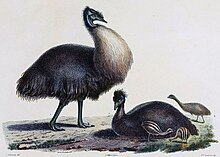
Back درميس Arabic درميس ARZ Narkoy (Dromaius) AVK Emu Azerbaijani Емута Bulgarian Emou Breton Dromaius Catalan Dromaius CEB Emus German Dromaius Esperanto
| Dromaius Temporal range:
| |
|---|---|

| |
| Dromaius novaehollandiae | |
| Scientific classification | |
| Domain: | Eukaryota |
| Kingdom: | Animalia |
| Phylum: | Chordata |
| Class: | Aves |
| Infraclass: | Palaeognathae |
| Order: | Casuariiformes |
| Family: | Casuariidae |
| Genus: | Dromaius Vieillot, 1816[1] |
| Type species | |
| Casuarius novaehollandiae[2] Latham, 1790
| |
| Species | |
|
D. novaehollandiae (Latham, 1790) Vieillot, 1816 | |

| |
| Geographic distribution of emu taxa and historic shoreline reconstructions around Tasmania | |
| Synonyms | |
|
Dromiceius (sic) Vieillot, 1816 | |
Dromaius (from greek δρομαίυς "runner") is a genus of ratite present in Australia. There is one extant species, Dromaius novaehollandiae, commonly known as the emu.
In his original 1816 description of the emu, Louis Pierre Vieillot used two generic names; first Dromiceius, then Dromaius a few pages later. Which label is correct has been a point of contention ever since; the latter is more correctly formed, but the convention in taxonomy is that the first name given stands, unless it is clearly a typographical error, as argued by W.B. Alexander.[3] For names published on the same day, or in the same publication, the International Code of Zoological Nomenclature states that both names have equal precedence, and that the Principle of First Reviser (Article 24.2 [4]) determines which name is to be used. Most modern publications, including those of the Australian government,[5] use Dromaius, with Dromiceius mentioned as an alternative spelling. Misspellings of both forms by later authors have produced further synonyms.[5] The Dromiceius spelling was the basis for Dale Russell's 1972 naming of the dinosaur Dromiceiomimus.

- ^ Brands, Sheila. "Genus Dromaius". The Taxonomicon. Retrieved 19 September 2017.
- ^ "Cassuaridae". aviansystematics.org. The Trust for Avian Systematics. Retrieved 2023-08-05.
- ^ Alexander, W. B. (1927). "Generic Name of the Emu". Auk. 44 (4): 592–593. doi:10.2307/4074902. JSTOR 4074902.
- ^ International Code of Zoological Nomenclature Article 24
- ^ a b Genus Dromaius Vieillot, 1816. Australian Faunal Directory
- ^ Pfennigwerth, S. (2010). "(William T. Stearn Prize 2009) "The mighty cassowary": The discovery and demise of the King Island emu". Archives of Natural History. 37: 74–90. doi:10.3366/E0260954109001661.
© MMXXIII Rich X Search. We shall prevail. All rights reserved. Rich X Search